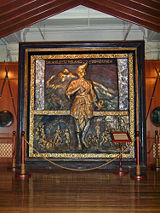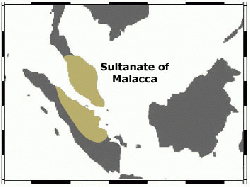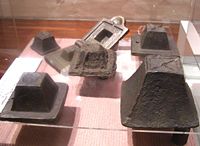Malacca Sultanate
The Sultanate of Malacca was founded by Parameswara in 1402 and later married the princess of Pasai in 1409. Centered in the modern town of Malacca, the sultanate stretched from southern Thailand in the north to Sumatra in the southwest. The Portuguese invaded its capital in 1511 and in 1528, the Sultanate of Johor was established by a Malaccan prince to succeed Malacca.
Establishment of Malacca
Template:History of Malaysia Parameswara founded Malacca around 1400. He was a Buddhist Srivijayan prince and Sejarah Melayu mentioned that he laid claims of being descended from the Macedonian King Alexander the Great / Iskandar Zulkarnain. When Parameswara became the ruler of Palembang, the Srivijaya Empire was already in decline. In 1390s, Majapahit sent thousands of ships to attack Palembang. Parameswara had fled his palace and eventually reached Temasik island which was headed by a Srivijayan descendent. However, Temasik had been a vassal of Majapahit since 1365. After several days, Parameswara was betrayed by his relative and he had to kill him. Parameswara then ruled Temasik for about 4 years, where he was finally attacked by the Majapahit armies when one of the ministers opened the gates for Majapahit armies to attack the palace. Parameswara fled north to Muar before founding Melaka in 1400. In 1409, Parameswara assumed the title Sultan Iskandar Syah due to his marriage to a princess from Pasai. Although he did not convert to Islam, his marriage to the Muslim princess encouraged a number of his subjects to embrace Islam. According to the Sejarah Melayu, legend has it that the king saw a mouse deer outwit a dog when he was resting under the Melaka tree. He took what he saw as a good omen and decided to establish a capital for his kingdom there. Today, the mouse deer is part of modern Malacca's coat of arms.
Administration
| Sultan of Malacca | Reign |
|---|---|
| Parameswara | 1400 - 1414 |
| Megat Iskandar Shah | 1414 - 1424 |
| Muhammad Shah | 1424 - 1444 |
| Abu Syahid | 1444 - 1446 |
| Muzaffar Shah | 1446 - 1459 |
| Mansur Shah | 1459 - 1477 |
| Alauddin Riayat Shah | 1477 - 1488 |
| Mahmud Shah | 1488 - 1528 |
Malacca had a well-defined government with a set of laws. On top of the sultanate's hierarchy sat the sultan and he was an absolute monarch. Below him was a bendahara, a position similar to that of a prime minister. Most of all, a bendahara was an adviser to the sultan. A bendahara is a common person appointed by the sultan and it was the highest ranking officer that could be held by any common people. After bendahara, a laksamana's authority is paramount. A laksamana is an admiral and was responsible for the state and the sultan's security. He commanded the army. Later comes the temenggung which more or less a chief of public police. At the bottom of this nobility structure are penghulu bendahari, who was the treasurer of the state and the shahbandars of whom were responsible to matters of trade and ports.
The most famous Malaccan bendahara is Tun Perak. Under his advice, he managed to expand Malacca to its greatest extent. Hang Tuah is an example of Malaccan laksamana.
The sultanate was governed with several set of laws. The formal legal text of traditional Melaka consisted of the Undang-Undang Melaka (Laws of Malacca), variously called the Hukum Kanun Melaka and Risalat Hukum Kanun, and the Undang-Undang Laut Melaka (the Maritime Laws of Malacca). The laws as written in the legal digests went through an evolutionary process. The legal rules that eventually evolved were shaped by three main influences, namely the early non-indigenous Hindu/Buddhist tradition, Islam and the indigenous "adat."
Factors for growth

The Sultanate thrived on entrepôt trade and became the most important port in Southeast Asia during the 15th and the early 16th century. Furthermore, Malacca was as a major player in the spice trade, serving as a gateway between the Spice Islands and high-paying Eurasian markets. This is reflected by the Portuguese writer Duarte Barbosa who wrote "He who is lord of Malacca has his hand on the throat of Venice."
One of the factors that contributed to the rise of Malacca was the monsoon winds that enabled Arab and Indian traders from the west to travel to China in the east and vice versa. At the height of its power, the Sultanate encompassed most of modern day Peninsular Malaysia, the site of modern day Singapore and a great portion of eastern Sumatra. It was also the center of Islam in the eastern sphere, where imams and ustazes came to discuss religion and the like. Muslim missionaries were also sent by the Sultan to spread Islam to other communities in the Malay Archipelago, such as in Java, Borneo, and the Philippines. Most of South East Asia at that time was Hindu.
The Sultanate's most important regional rivals were Siam in the north and the declining Majapahit Empire in the south. Majapahit was not able to control or effectively compete with Malacca within the archipelago, and came to an end during the later 15th century. Siam on the other hand attacked Malacca three times, but all attacks were repelled.
At the same time, Malacca had a good relationship with Ming, resulting in Zheng He's visits. Parameswara had met the Ming emperor to receive a Letter of Friendship, hence making Malacca the first foreign kingdom to attain such treatment. In 1409, the sultan paid tribute to the Ming emperor to ask for protection against Siam. Moreover, one of the sultans, Mansur Shah even married a Ming princess named Hang Li Po. This Sino-Malacca relationship helped deter Siam from further threatening Malacca.(See Zheng He In Malacca.)
Portuguese invasion and its effects
| This article is part of the History of Indonesia series |
|---|

|
| See also: |
| Prehistory |
| Early kingdoms |
| Srivijaya (third to fourteenth centuries) |
| Sailendra (eighth & ninth centuries) |
| Kingdom of Mataram (752–1045) |
| Kediri (1045–1221) |
| Singhasari (1222–1292) |
| Majapahit (1293–1500) |
| The rise of Muslim states |
| The spread of Islam (1200–1600) |
| Malacca Sultanate (1400–1511) |
| Sultanate of Demak (1475–1518) |
| Aceh Sultanate (1496 - 1903) |
| Mataram Sultanate (1500s to 1700s) |
| Colonial Indonesia |
| The Portuguese in Indonesia (1512-1850) |
| Dutch East India Company (1602–1799) |
| Dutch East Indies (1800–1942) |
| The emergence of Indonesia |
| National Revival (1899–1942) |
| Japanese Occupation (1942-45) |
| Declaration of Independence (1945) |
| National Revolution (1945–1950) |
| Independent Indonesia |
| Liberal Democracy (1950-1957) |
| Guided Democracy (1957-1965) |
| Transition to the New Order (1965–1966) |
| The New Order (1966-1998) |
| Reformation Era (1998–present) |
| [Edit this template] |
Hearing of Malacca's great wealth coming from Asian traders, the Portuguese king sent Admiral Lopes de Sequeira to find Malacca, to make a friendly compact with its ruler and to stay on Portugal's representative east of India. The first European to reach Malacca and Southeast Asia, Sequeira arrived in Malacca in 1509. Although he was initially well-received by Sultan Mahmud Shah trouble however quickly ensued.[1] The general feeling of rivalry between Islam and Christianity was invoked by a group of Goa Muslims in the sultan's court after the Portuguese had captured Goa.[2] The international Muslim trading community convinced Mahmud that the Portuguese were a grave threat. Mahmud subsequently captured several of his men, killed others and attempted to attack the four Portuguese ships, although they escaped. As the Portuguese had found in India, conquest would be the only way they could establish themselves in Malacca.[1]
In April 1511, Afonso de Albuquerque set sail from Goa to Malacca with a force of some 1200 men and seventeen or eighteen ships.[1] The Viceroy made a number of demands - one of which was for permission to build a fortress as a Portuguese trading post near the city. [2]. All the demands were refused by the Sultan. Conflict was unavoidable, and after 40 days of fighting, Malacca fell to the Portuguese on August 24. Although Malacca seems to have been well supplied with artillery, but the combination of Portuguese firepower, determination and fanatical courage prevailed. A bitter dispute between Sultan Mahmud and his son Sultan Ahmad also weighed down the Malaccan side.[1]
Albuquerque remained in Malacca until November 1511 preparing its defences against any Malay counterattack.[1] Sultan Mahmud Shah was forced to flee Malacca. The sultan made several attempts to retake the capital but his efforts were fruitless. The Portuguese retaliated and forced the sultan to flee to Pahang. Later, the sultan sailed to Bintan and established a new capital there. With a base established, the sultan rallied the disarrayed Malay forces and organized several attacks and blockades against the Portuguese's position. Frequent raids on Malacca caused the Portuguese severe hardship. The raids helped convince the Portuguese that the exiled sultan's forces must be silenced. A number of attempts were made to suppress the Malay forces, but it wasn't until 1526 that the Portuguese finally razed Bintan to the ground. The sultan then retreated to Kampar in Sumatra where he died two years later. He left behind two sons named Muzaffar Shah and Alauddin Riayat Shah II.
Muzaffar Shah was invited by the people in the north of the peninsula to become their ruler, establishing the Sultanate of Perak. Meanwhile, Mahmud's other son, Alauddin succeeded his father and made a new capital in the south. His realm was the Sultanate of Johor, the successor of Malacca.
It soon became clear that Portuguese control of Malacca did not mean they now controlled Asian trade that centred around it. Their Malaccan rule was marred with difficulties: they could not become self-supporting and remained reliant on Asian suppliers (as had their Malay predecessors); they were short of both funds and manpower; and administration was hampered by organisational confusion and command overlap, corruption and inefficiency. Competition from other ports such as Johor saw Asian traders bypass Malacca and the city began to decline as a trading port.[3] Rather than achieving their ambition of dominating it, the Portuguese had fundamentally disrupted the organisation of the Asian trade network. Rather than a centralised port of exchange of Asian wealth exchange, or a Malay state to police the Straits of Malacca that made it safe for commercial traffic, trade was now scattered over a number of ports amongst bitter warfare in the Straits.[3]
Malacca was later conquered by the Dutch in 1641. Through the Anglo-Dutch Treaty of 1824, Malacca became a colony of the United Kingdom. In 1957, Malacca joined other Malay states to form Malaya and in 1963, together with Sarawak, Sabah and Singapore formed Malaysia.
Fei Xin's description of Malacca
Fei Xin (Chinese: 费信) was the Ming dynasty admiral Zheng He's translator. In his Description of the Starry Raft (1436), early Malacca was included.
He noted that Malacca people which was the Malays had "their skin resembled black lacquer, but there were some white-skinned people among them who are of ethnic Tang. Men and women appeared in mallet-like chignon hair style, simple and kind lifestyle, they fish at rivers and at sea. The coastal village was inhabited by very few peoples and was not ruled by any neighboring kingdoms. The only produce of Malacca was tin, from a river. Tins obtained from river were fired into tin block (konwn as Tin ingot) where each weigh 1.4 jin. Malacca paid annual 40 golds to Siam as tax...."[4]
Malacca's Tin ingot
Tin ingots were a trading currency unique to Malacca. Cast in the shape of a peck, each block weighs just over one pound. Ten blocks made up one unit called a 'small bundle', and 40 blocks made up one 'large bundle'.
ReferencesISBN links support NWE through referral fees
General
- ↑ 1.0 1.1 1.2 1.3 1.4 Ricklefs, M.C. (1991). A History of Modern Indonesia Since c.1300, 2nd Edition. London: MacMillan, p.23. ISBN 0-333-57689-6.
- ↑ 2.0 2.1 Mohd. Fawzi bin Mohd. Basri and Mohd Fo'ad bin Sakdan; Azami bin Man (2002). Kurikulum Bersepadu Sekolah Menengah Sejarah Tingkatan 1. Kuala Lumpur: Dewan Bahasa dan Pustaka, p.95. ISBN 983-62-7410-3.
- ↑ 3.0 3.1 Ricklefs, M.C. (1991). A History of Modern Indonesia Since c.1300, 2nd Edition. London: MacMillan, p.23-24. ISBN 0-333-57689-6.
- ↑ When China Ruled the Seas: The Treasure Fleet of the Dragon Throne, 1405-1433 by Louise Levathes (ISBN 0-19-511207-5)
External links
See also
- Sultanate of Johor
- Sultanate of Kedah
Credits
New World Encyclopedia writers and editors rewrote and completed the Wikipedia article in accordance with New World Encyclopedia standards. This article abides by terms of the Creative Commons CC-by-sa 3.0 License (CC-by-sa), which may be used and disseminated with proper attribution. Credit is due under the terms of this license that can reference both the New World Encyclopedia contributors and the selfless volunteer contributors of the Wikimedia Foundation. To cite this article click here for a list of acceptable citing formats.The history of earlier contributions by wikipedians is accessible to researchers here:
The history of this article since it was imported to New World Encyclopedia:
Note: Some restrictions may apply to use of individual images which are separately licensed.


